

Gartner predicts 3D printers will cost less than a PC by 2016. Cities Of The Future, Built By Drones, Bacteria, And 3-D Printers. As complex ecosystems, cities are confronting tremendous pressures to seek optimum efficiency with minimal impact in a resource-constrained world.

While architecture, urban planning, and sustainability attempt to address the massive resource requirements and outflow of cities, there are signs that a deeper current of biology is working its way into the urban framework. Innovations emerging across the disciplines of additive manufacturing, synthetic biology, swarm robotics, and architecture suggest a future scenario when buildings may be designed using libraries of biological templates and constructed with biosynthetic materials able to sense and adapt to their conditions. Construction itself may be handled by bacterial printers and swarms of mechanical assemblers. Much of the modern built environment we experience began its life in CAD software. In the Bio/Nano/Programmable Matter lab at Autodesk Research, engineers are developing tools to model the microscopic world. 3D printed guns are going to create big legal precedents. By now, everyone's heard about the 3D printed gun that Defense Distributed demonstrated last week.

The Texas-based group has been steadily working its way up the 3D printed firearms evolutionary ladder, making parts for guns, then guns themselves, then firing a gun, then making the plans for running up your own pistols on a nearby 3D printer. If Defense Distributed had set out to create a moral panic over 3D printing, they could have picked no better project. The prevailing opinions on 3D printed guns fall into two major categories: the apocalyptic and the nonchalant. The apocalyptics – including grandstanding politicos like New York State senator Steve Israel, who's already introduced legislation aimed at banning 3D printed guns – greet this news with hysterics: the age of the undetectable plastic gun to be upon us, and Something Must Be Done.
How to 3-D Print the Skeleton of a Living Animal. The skeleton above was created by taking a CT scan of an anesthetized rat and sending the data to a 3-D printer.
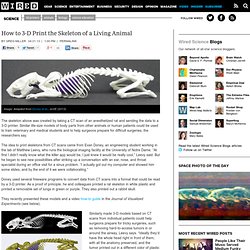
Similar life-size models of body parts from other animals or human patients could be used to train veterinary and medical students and to help surgeons prepare for difficult surgeries, the researchers say. The idea to print skeletons from CT scans came from Evan Doney, an engineering student working in the lab of Matthew Leevy, who runs the biological imaging facility at the University of Notre Dame. ”At first I didn’t really know what the killer app would be, I just knew it would be really cool,” Leevy said.
But he began to see new possibilities after striking up a conversation with an ear, nose, and throat specialist during an office visit for a sinus problem. “I actually got out my computer and showed him some slides, and by the end of it we were collaborating.” X-ray CT (top) and stereolithographic (bottom) renderings used to produce the rat skeleton above. How Many People Will Own 3D Printers? Getting to One Million Sold.
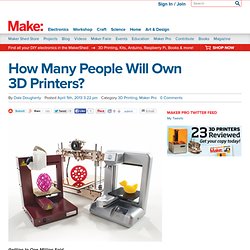
3D-Printed Skull Implant Ready for Operation. 3D printing technology has helped replace 75 percent of a patient's skull with the approval of U.S. regulators.
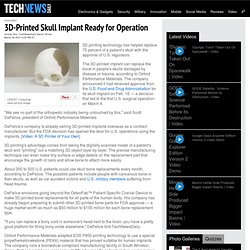
The 3D-printed implant can replace the bone in people's skulls damaged by disease or trauma, according to Oxford Performance Materials. The company announced it had received approval from the U.S. Lessig's Harvard Law lecture: "Aaron's Law" Vortex smoke rings created with 3D printed wings. Dustin Kleckner sez, "Scientists tie vortex rings (smoke rings, basically) into knots using 3D printed wings.
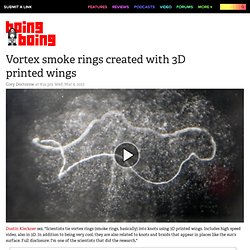
Includes high speed video, also in 3D. In addition to being very cool, they are also related to knots and braids that appear in places like the sun's surface. Full disclosure: I'm one of the scientists that did the research. " The duo overcame their experimental difficulties by designing and fabricating various hydrofoils (wings used in water) on a 3-D printer. How Big Business is Stymying Makers' High-Res, Colorful Innovations. If you're waiting for desktop additive-manufacturing technology to move closer to professional-level results, be prepared to wait for a very long time.
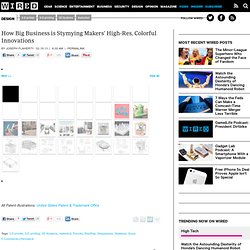
The past year was a breakout for desktop 3-D printing. MakerBot released two new models, Formlabs debuted the first prosumer 3-D printer to use high-accuracy stereolithography, and a slew of innovative, printed projects lifted awareness and desirability of additive manufacturing for the general public. But the year ended with a legal hiccup. PBS short documentary about 3D printing. PBS OffBook made this excellent 7-minute introduction to 3D printing.
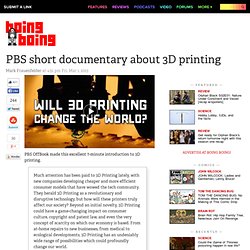
Much attention has been paid to 3D Printing lately, with new companies developing cheaper and more efficient consumer models that have wowed the tech community. They herald 3D Printing as a revolutionary and disruptive technology, but how will these printers truly affect our society? Beyond an initial novelty, 3D Printing could have a game-changing impact on consumer culture, copyright and patent law, and even the very concept of scarcity on which our economy is based. From at-home repairs to new businesses, from medical to ecological developments, 3D Printing has an undeniably wide range of possibilities which could profoundly change our world. Dreambox 3D Printer Vending Machine Creates and Dispenses Designs Before Your Eyes. UC Berkeley’s new Dreambox is a vending machine like no other – it incorporates a 3D printer that makes and dispenses goodies right before your eyes!
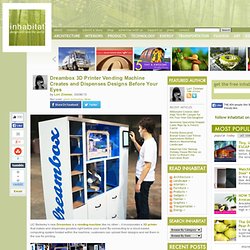
By connecting to a cloud-based computing system hosted within the machine, customers can upload their designs and set them in the cue for printing. The designers of Dreambox wanted a place for 3D printing enthusiasts to see their designs being created—a treat they don’t get to see if they place an order online or with a print shop. The renderings are processed, printed, and then (like any other vending machine) popped into a drawer for the customer to collect. Smoothing 3D prints with acetone and without patent violations.
Austin Wilson and Neil Underwood from the North Carolina makerspace Fablocker invented a great, simple process for smoothing out 3D prints using evaporated nail-polish remover in a large jar.
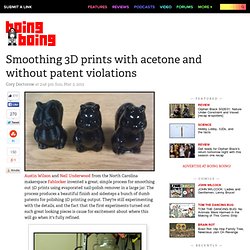
The process produces a beautiful finish and sidesteps a bunch of dumb patents for polishing 3D printing output. They're still experimenting with the details, and the fact that the first experiments turned out such great looking pieces is cause for excitement about where this will go when it's fully refined. Guest Post: Cory Doctorow for Freedom to Read Week. ← Back to Blog by Dan Guest Blogger + YA Fiction / February 24, 2013 Freedom to Read Week is an annual event that encourages Canadians to think about and reaffirm their commitment to intellectual freedom, which is guaranteed them under the Charter of Rights and Freedoms.
To mark this year's Freedom to Read Week, which starts today, we asked author Cory Doctorow to contribute a guest post on libraries and technology. Pwdr - Open source powder-based rapid prototyping machine. The shape of things to come: A consumer's guide to 3D printers. CES 2013 proved to be something of a coming out party for consumer-facing 3D printers. Sure MakerBot earned a fair amount of attention at last year's show with the announcement of the Replicator, which snagged its share of awards from various press outlets. This year, however, saw a relative deluge in 3D-printing representation, with strong showings from 3D Systems, FormLabs, MakerBot and the cloud-based 3D printer, Sculpteo. Even with so many companies rising to prominence, the dream of truly mainstream 3D printing still feels a ways off -- if that is indeed where we're inevitably heading.
What's the Deal with Copyright and 3D Printing? DIY BioPrinter. We started out by messing around with an old inkjet printer that we literally saved from a sidewalk somewhere. There's already plenty of interesting things you can do with an low-end off-the-shelf inkjet printer, but they do have some limitations, which we'll get into in the next Step (or skip straight to Step 3 for how we built our own bioprinter from scratch, that you can see in the first picture above). Undressing the Printer We disassembled an abandoned HP 5150 inkjet printer for use as a bioprinter. Just rip off all the plastic covers you can find, but make sure you can still operate the reset buttons etc. on the front panel. There's a little momentary switch that senses whether the cover is open.
There's also a momentary switch inside the paper handling mechanism that senses whether paper has been loaded.